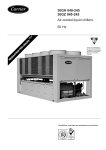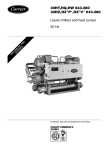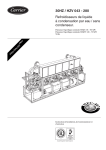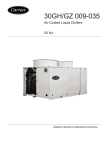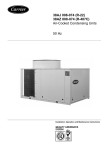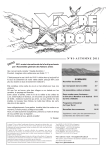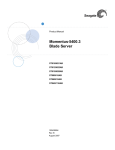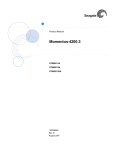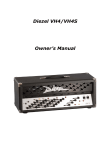Download Carrier GY Operating instructions
Transcript
30GV/30GY 020-059 Air-Cooled Liquid Chillers 50 Hz Installation, Operation and Maintenance Instructions 1 CONTENTS Page Start-up checklist .......................................................................................................................................................................... 3 Dimensions and clearances .......................................................................................................................................................... 4 Physical and electrical data ......................................................................................................................................................... 6 Application data ............................................................................................................................................................................ 7 Minimum and maximum cooler water flow rates .......................................................................................................................... 7 Minimum operating temperature .................................................................................................................................................... 7 Water loop volume ......................................................................................................................................................................... 7 Installation ..................................................................................................................................................................................... 7 Safety considerations .................................................................................................................................................................... 7 Preliminary checks ......................................................................................................................................................................... 8 Moving and lifting the unit ............................................................................................................................................................. 8 Positioning of 30GV, GY 044-059 units ........................................................................................................................................ 8 Duct connections ............................................................................................................................................................................ 8 Fan module ..................................................................................................................................................................................... 9 Fan speed adjustment tables ........................................................................................................................................................... 9 Fan laws .......................................................................................................................................................................................... 9 Water connections ...................................................................................................................................................................... 10 Power supply ............................................................................................................................................................................... 12 Electrical checks ........................................................................................................................................................................... 12 Start-up ........................................................................................................................................................................................ 12 Preliminary checks ....................................................................................................................................................................... 12 Actual start-up .............................................................................................................................................................................. 13 Electromechanical control ............................................................................................................................................................ 13 Set point adjustment ..................................................................................................................................................................... 13 Control pressostats ........................................................................................................................................................................ 13 Servicing refrigeration components .......................................................................................................................................... 14 General maintenance .................................................................................................................................................................... 14 Liquid refrigerant charging ........................................................................................................................................................... 14 Compressors ................................................................................................................................................................................. 15 Compressor motor protection ...................................................................................................................................................... 15 Heat exchangers ............................................................................................................................................................................ 15 Evaporator .................................................................................................................................................................................... 15 Condenser coil .............................................................................................................................................................................. 16 Fan motor replacement ................................................................................................................................................................. 17 Troubleshooting chart ................................................................................................................................................................ 18 START-UP CHECK LIST Equipment sold by: Contract No.: Installed by: Contract No.: Site address: Start-up date: Equipment type and serial numbers: Electrical data: Supply voltage: Ph. Nominal voltage: V Current draw: Ph. 1 V Ph. 2 V Ph. 3 V A Ph. 3 A % network voltage: A Ph. 2 Main circuit breaker rating: A Physical data: Condenser: Cooler: Entering air temperature: °C Entering water temperarture: °C Leaving air temperature: °C Leaving water temperature: °C Pressure drop (air): kPa Discharge air pressure: Pa Fan speed: Pressure drop (water): kPa Suction pressure: kPa r/s or rpm Fan motor input: Ph. 1 V Ph. 2 V Ph. 3 V Ph. 1 V Ph. 2 V Ph. 3 V Safety device setting: High pressure switch: cut-out kPa: cut-in kPa Low-pressure switch: cut-out kPa cut-in kPa Safety thermostat: cut-out °C cut-in °C Control thermostat: cut-out first step °C cut-in first step °C cut-out second step °C cut-in second step °C Oil level: Oil visible in sight glass?: Colour of moisture indicator: Air bubbles visible in sight glass?: Accessories: Commissioning engineer (name): Purchase order number: NOTE: Please fill in this sheet during the installation Dimensions and clearances 30GV/30GY 020 36 36 1868 36 2103 800 915 A 600 800 950 B A-B: Clearance only required on one side 30GV/30GY 025-035 36 36 2028 36 3327 600 800 983 A 1800 800 950 B A-B: Clearance only required on one side 4 Dimensions and clearances, mm 36 36 2028 36 36 30GV/30GY 044-059 2000 1000 3327 1800 950 1000 1800 Alternative 1 Alternative 2 Floor mounting • • For unit mounting holes, weight distribution and centre of gravity coordinates, refer to the dimensional drawings supplied with the unit. These units are designed for indoor installation. CAUTION: • • Ensure the air flow around the unit is not obstructed. At least one side of the units must be free from obstructions, to ensure proper air flow. 5 Physical data 30GV/30GY 020 025 030 035 044*** 049*** 059*** Nominal cooling capacity 30GV* kW Nominal cooling capacity 30GY* kW 51 50 66 69 73 97 97 101 132 138 146 153 193 202 Operating weight kg 850.0 1030.0 1100.0 1250.0 2111.5 2255.0 2562.5 Refrigerant charge**** kg 9.8 14.5 15.2 17.0 29.0 29.0 34.0 1/2** 66/100 1/2** 66/100 1/1 3 33/66/100 1/1 3 33/66/100 1/1 3 33/66/100 31.0 43.0 62.0 62.0 86.0 2 FPT 2 MPT 1000 2 FPT 2 MPT 1000 3 FPT 3 FPT 1000 3 FPT 3 FPT 1000 3FPT 3FPT 1000 6900 10.53 4.5 24.2 Two, double centrifigal 11200 11200 10.33 10.67 2 x 4.0 2 x 4.0 24.2 24.2 Compressor Quantity Circuit A/B No. of capacity steps Capacity control Semi-hermetic, 4 or 6 cylinders, 24.2 r/s % 1/2 50/100 1/2** 66/100 Evaporator Net water volume l Water connections in Inlet Outlet Max. water side operating pressure kPa Coaxial Shell-and-tube 21.7 31.0 BSPC, conical gas, ISO R7 2-1/2 MPT 2 FPT 2-1/2 MPT 2 MPT 1000 1000 Condenser Condenser fan Nominal air flow Speed at 150 Pa ESP Nominal fan motor power Motor speed Copper tubes, al;uminium fins Single centrifugal Double centrifugal 3500 5600 5600 10.33 10.33 10.67 3.0 4.0 4.0 24.2 24.2 24.2 l/s r/s kW r/s 13800 10.83 2 c 4.5 24.2 * Based on 12°C/7°C entering/leaving chilled water temperature, 35°C condenser entering air temperature and nominal fan speed. ** 3 steps with capacity reduction accessory *** Supplied as two separate units as follows, with all electrical, hydraulic and mechanical components necessary for installation: size 044 = 2 x size 025, size 049 = 2 x size 030, size 059 = 2 x size 035 **** 30GY units use refrigerant R-22, 30GV units use R-407C. The refrigerant charge shown is guidelines only. Always refer to the nameplate. Electrical data 30GV/30GY Standard unit Fan 150 Pa 300 Pa (optional) V-ph-Hz RLA XL ICF PW ICF kW FLA kW FLA 020 230-3-50 400-3-50 62 36 263 180 163 111 3.7 3.7 11.7 6.3 4.9 4.9 15.7 9.0 025 230-3-50 400-3-50 84 48 359 232 222 143 4.9 4.9 15.7 9.0 8.8 8.8 26.4 15.2 030 230-3-50 400-3-50 94 54 383 262 237 161 4.9 4.9 15.7 9.0 8.8 8.8 26.4 15.2 035 230-3-50 400-3-50 135 77 564 356 346 218 5.5 5.5 17.9 10.3 8.8 8.8 26.4 15.2 044 230-3-50 400-3-50 167 96 442 280 305 191 9.8 9.8 2 x 15.7 2 x 9.0 17.6 17.6 2 x 26.4 2 x 15.2 049 230-3-50 400-3-50 187 108 476 316 330 215 9.8 9.8 2 x 15.7 2 x 9.0 17.6 17.6 2 x 26.4 2 x 15.2 059 230-3-50 400-3-50 270 154 699 433 808 295 11.0 11.0 2 x 17.9 2 x 10.3 17.6 17.6 2 x 26.4 2 x 15.2 Legend: FLA - Full load amperes ICF - Maximum instantaneous current flow, A (compressors) kW - Maximum fan motor power input RLA - Rated load amperes (compressors) PW - Part-winding astart (compressors) XL - Across-the-line-start (compressors) Note: To obtain the maximum unit current, add the compressor maximum currecnt (RLA) to the fan motor current (FLA). 6 APPLICATION DATA INSTALLATION Minimum and maximum evaporator water flow rates 30GY/GV Min flow rate, l/s Max. flow rate, l/s 020 025 030 035 044 049 059 1.2 1.6 1.6 2.4 3.2 3.2 4.8 4.8 8.0 8.0 9.4 16.0 16.0 18.4 Installation, start-up and servicing this equipment can be hazardous due to system pressures, electrical components and equipment location (roofs, elevated structures, etc.). Only trained, qualified installers and service mechanics should install, start-up and service this equipment. Minimum operating temperature °C Single-speed motor Two-speed motor Dampers SAFETY CONSIDERATIONS 14 4 -20 Untrained personnel can perform basic functions, such as cleaning coils. All other operations should be performed by trained service personnel. When working on the equipment, observe precautions in the literature, and on tags, stickers, and labels attached to the equipment. Maximum chilled water flow rate The maximum chilled water flow (>0,09 l/s per kW or <2.8 K temperature difference) is limited by the maximum permitted pressure drop in the evaporator. Water loop volume Whatever the size of the system, the water loop minimum volume is given by the following formula: Volume = CAP (kW) x N* = litres where CAP is the nominal system capacity (kW) at the nominal operating conditions of the installation. Application N* Air conditioning Industrial process cooling Low temperature operation 3.25 6.5 10.8 • • • Follow all safety codes. Wear safety glasses and work gloves. Use care in handling, rigging and setting down bulky equipment. WARNING: Before doing any work ensure that the power supply (400 V and 230 V) is disconnected, and switches and isolators are opened and tagged. During operation some parts of the unit reach or exceed temperatures of 70°C (e.g. compressor discharge side, discharge line). Only trained and qualified engineers, aware of these hot surfaces, are allowed to perform maintenance operations. Preliminary checks This volume is necessary for stable operation and accurate temperature control. It is often necessary to add a buffer water reservoir to the circuit in order to achieve the required volume. The reservoir must itself be internally baffled in order to ensure proper mixing of the liquid (water or brine). Refer to the examples below. NOTE: The compressor must not restart more than 10 times in an hour. Check equipment received • Inspect the unit for damage or missing parts. If damage is detected, or if shipment is incomplete, immediately file a claim with the shipping company. • Confirm that the unit received is the one ordered. Compare the nameplate data with the order. • Confirm that all accessories ordered for on-site installation have been delivered, and are complete and undamaged. Moving and lifting the unit Moving Do not remove skids, pallets or protective packaging until the unit is in its final position. Move the chiller using tubes or rollers, or lift it, using slings of the correct capacity. Before moving the unit, ensure that all panels are correctly fixed. Lifting Refer to dimensional drawings 99 DI-035 GY 500 250E and the lifting instructions label on the unit. Bad Good Bad Good 7 Preliminary checks Before installing and connecting the unit check: The required clearances for correct unit operation and maintenance. Size and location of the chilled water piping. Location and electrical characteristics of the available power supply which must agree with the unit nameplate rating. Location and correct installation of the ductwork. That there is not only sufficient space for routine service and maintenance work, but also for operations such as: fan shaft inspection, compressor removal etc. Refer to the certified drawings for the units. Positioning Once the unit has been installed in its final location, remove the skids, level the unit with a spirit level and bolt it to the floor or to a pad. CAUTION: These units must not be installed outside, except under cover. If it is necessary to locate the unit on an upper floor, be sure that the structure is designed to support the weight. If required, strengthen the floor. Also ensure that the installation surface is level. Check the dimensional drawing for unit dimensions and weight distribution. Positioning of the 30GV/GY 044-059 units Mechanical connection Step 1 - 6-7 5 First position unit B (the control box of this unit does not include a disconnect switch). Fasten beams 2 and 3 with screw 6 and washer 7 to unit B. Move unit A close so that it can be fastened to beams 2 and 3 from the inside of the unit. 6-7 4 4 Unit A Unit B 3 1 6-7 Duct connections The fan motor assembly is mounted on a self-supporting frame, and permits connection to a ductwork system without using additional flexible connections. Suction side When designing ducts, the possible installation of accessory filters and air dampers must be taken into consideration. For 30GV,GY 044-059 units it is preferable to leave the two suction openings free. The units will also function correctly with only one suction opening. In this case it is necessary to increase the fan speed of the rear unit (in this case unit B) by 8% in relation to the front unit (unit A with direct air intake, in order to balance the air flows for the two modules. Discharge side For units 30GV,GY 025-035 the selection curves are based on a connection separated by two ducts (four for 30GV, GY 044 to 059). If this is not the case, the additional pressure, which is due to the change in the dynamic pressure, must be taken into account (see table below). CAUTION: The following rules for centrifugal fans must always be adhered to, in order to ensure that the maximum power input of the motor is not exceeded: The fan must not be rotated without the panels being fitted. The unit should not be operated without a discharge duct. Use panels to ensure that the suction or discharge opening cannot obstructed (e.g. bottom supply or opening of doors). Unit B Minimum outdoor operating temperature (°C) 2 3 2 6-7 2 2 3 Step 2 - - 8 Fasten panel 4 to the front of the assembly using screws 6 and washers 7, and panel 5 to the rear of the assembly using screws 6 and washers 7. Fasten the control box to front panel 4, which was previously fastened with screws 6 and washers 7. Unit size 020 025-059 % load Single-speed motor Two-speed motor Dampers 100 10 0 -20 50 12 2 -20 100 10 0 -20 66 12 2 -20 33 14 4 -20 Fan module Before the final start-up of the unit, check that the ductwork is correctly attached to the unit. After checking the correct positioning of the pulley elements on the shaft and the belt tension, the fan motor must be switched on, as follows: 1. Check the rated motor current on the nameplate. 2. Check that all panels are fitted. 3. Start the fan motor using a contactor. Measure the current. If the value is higher than the value established in step 1, or more than 15% below that value, it may be necessary to adjust the fan speed as shown in the following tables: Fan speed adjustment tables 30GV and 30GY 020 Air flow 6 r/s 7 r/s 8 r/s 9 r/s 10 r/s 11 r/s 12 r/s 13 r/s 14 r/s l/s ESP kW ESP kW ESP kW ESP kW ESP kW ESP kW ESP kW ESP kW ESP kW 1900 2100 2300 2500 2700 2900 3100 3300 3500 3700 3900 4100 4300 4500 4700 4900 5100 5300 61 52 40 27 12 0 0.6 0.7 0.8 0.8 0.9 97 89 79 67 53 37 20 1 0.9 1.0 1.1 1.2 1.3 1.4 1.4 137 130 121 110 98 83 67 50 30 8 0 1.1 1.3 1.4 1.5 1.6 1.8 1.9 2.0 2.1 2.2 180 174 167 157 146 133 118 102 84 63 42 18 0 1.4 1.6 1.7 1.8 2.0 2.1 2.3 2.4 2.6 2.7 2.9 3.0 226 222 216 208 198 186 173 158 141 122 101 79 55 29 1 1.7 1.8 2.0 2.2 2.4 2.5 2.7 2.9 3.1 3.2 3.4 3.6 3.8 3.9 277 274 269 262 253 243 231 217 201 184 165 144 121 96 70 41 11 0 1.9 2.1 2.3 2.5 2.7 2.9 3.1 3.3 3.5 3.7 3.9 4.1 4.4 4.6 4.8 5.0 5.2 330 329 325 320 312 303 293 280 266 250 232 212 190 167 142 115 86 55 2.2 2.4 2.6 2.9 3.1 3.3 3.6 3.8 4.0 4.2 4.5 4.7 4.9 5.2 5.4 5.6 5.9 6.1 388 387 385 381 375 367 358 347 334 319 302 284 263 241 217 192 164 135 2.4 2.7 3.0 3.2 3.5 3.7 4.0 4.2 4.5 4.8 5.0 5.3 5.5 5.8 6.0 6.3 6.5 6.8 445 446 445 442 437 431 425 413 401 388 372 355 336 316 293 269 243 215 2.7 3.0 3.3 3.5 3.8 4.1 4.4 4.7 5.0 5.3 5.5 5.8 6.1 6.4 6.7 7.0 7.2 7.5 30GV and 30GY 025-030-035 Air flow 6 r/s 7 r/s 8 r/s 9 r/s 10 r/s 11 r/s 12 r/s 13 r/s 14 r/s l/s ESP kW ESP kW ESP kW ESP kW ESP kW ESP kW ESP kW ESP kW ESP kW 3000 3500 4000 4500 5000 5500 6000 6500 7000 7500 8000 8500 9000 9500 10000 10500 60 52 41 28 12 0 0.9 1.1 1.3 1.4 1.6 89 83 74 62 47 30 10 0 1.2 1.4 1.6 1.8 2 2.2 2.4 122 117 109 99 86 70 52 31 7 0 1.5 1.7 2 2.2 2.5 2.7 2.9 3.2 3.4 157 153 147 138 127 113 96 77 55 30 2 1.8 2.1 2.4 2.7 2.9 3.2 3.5 3.8 4.1 4.4 4.7 194 193 188 181 171 158 143 125 105 81 56 27 0 2.0 2.4 2.8 3.1 3.5 3.8 4.2 4.6 4.9 5.3 5.6 6 235 235 232 226 217 206 193 176 157 136 111 85 55 23 0 2.3 2.7 3.2 3.6 4 4.5 4.9 5.3 5.8 6.2 6.6 7.1 7.5 7.9 278 279 278 274 267 257 245 230 213 193 170 145 117 86 53 17 3.1 3.6 4.1 4.7 5.2 5.7 6.2 6.7 7.3 7.8 8.3 8.8 9.3 9.9 10.4 10.9 324 327 327 324 319 311 300 287 271 253 231 208 181 152 120 86 3.7 4.3 4.9 5.5 6.1 6.8 7.4 8 8.6 9.2 9.8 10.4 11 11.7 12.3 12.9 373 377 379 378 374 367 358 347 332 315 296 273 248 221 190 158 4.3 5 5.8 6.5 7.2 7.9 8.6 9.4 10.1 10.8 11.5 12.2 12.9 13.7 14.4 15.1 ESP kW r/s External static pressure, Pa Fan motor power input, kW Revolutions per second Note : As units 30GV and 30GY 044 to 059 are two GV and GY 025 to 035 units connected, the tables above apply to them as well. Fan laws The fan laws state that for a given system resistance and air density: - The air flow rate varies as a direct function of the speed ratio: Qv2 The pressure varies as a function of the square value of the speed ratio: P2 The output varies as a function of the cube value of the speed ratio: Pa2 = Qv1 x N2/N1 = P1 x (N2/N1)2 = Pa1 x (N2/N1)3 9 Water connections Refer to the certified dimensional drawings for the sizes and positions of all water inlet and outlet connections. The water pipes must not transmit any radial or axial force to the heat exchangers or any vibration to the pipework or building. The water supply must be analysed and appropriate filtering, treatment, control devices, isolation and bleed valves and circuits built in, as necessary. Consult either a water treatment specialist or appropriate literature on the subject. Operating precautions The water circuit should be designed to have the least number of elbows and horizontal pipe runs at different levels. Below the basic checks to be done (see also the illustration of a typical hydraulic circuit below). • • • • • • • • • Note the water inlets and outlets of the heat exchangers. Install manual or automatic air purge valves at all high points in the water circuit. Use an expansion chamber or an expansion/relief valve to maintain pressure in the system. Install water thermometers in both the entering and leaving water connections close to the evaporator. Install drain valves at all low points to allow the whole circuit to be drained. Connect a stop valve in the drain line before operating the chiller. Install stop valves, close to the evaporator, in the entering and leaving water lines. Use flexible connections to reduce the transmission of vibration to the pipework. Insulate all pipework, after testing for leaks, both to reduce thermal leaks and to prevent condensation. Cover the insulation with a vapour barrier. Typical hydraulic circuit diagram Control valve Air vent Flow switch Flexible connection Heat exchanger Buffer tank Fill valve Pressure tap Thermostat sleeve Filter Expansion tank 10 Drain Water connections (30GY/GV 044-059) There are two alternatives: Water entering at the left of the duplex unit and leaving on the right. Water entering at the right of the duplex unit and leaving on the left. The water inlet must be on one evaporator, and the outlet on the other one, in order to correctly balance the flow rates in the evaporators. When installing and connecting the components ensure that there is no leak at any of the connections (see diagram below). IMPORTANT: The heat exchanger can be damaged by frost in winter. Depending on the atmospheric conditions in your area you can: Add ethylene glycol. Increase the thickness of the insulation. Never disconnect the evaporator heaters. If the unit is not used for a prolonged period, empty the the heat exchanger and add ethylene glycol. At the beginning of the following season, again fill the unit with water and an added inhibitor. If auxiliary equipment is installed, the installer must follow basic installation principles and ensure that the minimum and maximum flow rates are not exceeded; the values must be between the values given in the Physical Data table. Water connections (30GV/GY 044-059) Second alternative First alternative Water inlet Water outlet Evaporator 2 Refrigerant inlet and outlet Evaporator 1 Water outlet Water inlet Evaporator 2 Evaporator 1 Refrigerant inlet and outlet 11 Power supply Start-up The power supply must conform to the specification on the chiller nameplate. The supply voltage must be within the range specified in the electrical data table. Preliminary checks Never be tempted to start the chiller without reading fully, and understanding, the operating instructions and without having carried out the following pre-start checks : For connections refer to the wiring diagram. • Electrical connections (30GY/GV 044-059) Carry out the electrical connections between the control boxes in accordance with the diagram below and with the wiring diagram supplied with the unit; ensure that the cables are routed through the conduits. • All cables are labeled A B C D and E F (option 70). Electrical connections Control box B • Control box A • 1 • • D D A C C B • B • A WARNING: Operation of the chiller with an improper supply voltage or with excessive phase imbalance constitutes abuse which will invalidate the Carrier warranty. If the phase imbalance exceeds 2% for voltage, or 1% for current, contact your local electricity supply company at once and ensure that the chiller is not switched on until corrective measures have been taken. • • • • • Voltage phase imbalance (%) : = 100 x max.deviation from average voltage deviation Average voltage Electrical checks WARNING: Never switch off the power supply to the crankcase heaters unless the chiller is out of service for a seasonal shutdown or lengthy repair. The heaters must be re-energised for at least 24 hours before the chiller is restarted. a. b. c. d. e. 12 Switch the unit off. Open the control circuit disconnect switch. Check the transformer connections. Ensure that the control circuit corresponds to the wiring diagram for the unit. Check that all electrical connections are secure at the terminals, contactors, bus bars and compressor terminal blocks. • • • Confirm that all crankcase heaters are working by feeling all compressor crankcases. Every compressor has a 200 W cartridge heater (see the wiring diagram). The heater remains energised even when the chiller is shut down to stop the lubricating oil from absorbing refrigerant. Check the operation of all accessories - chilled water circulating pumps, air handlers and other equipment connected to the evaporator. Follow the individual manufacturer's instructions for this equipment. It is recommended to connect the auxiliary contact of the water pump contactor to ensure maximum unit safety (see wiring diagram delivered with the unit). Fill the chilled water circuit with clean water, and an inhibitor formulated specifically for this purpose, or fill it with another non-corrosive fluid to be chilled. Purge air at all high points in the system. If water temperatures below 5°C are likely, add the appropriate volume of ethylene glycol to prevent freezing. Confirm that the suction and discharge line stop valves are fully opened. Open the refrigerant line valves. Check again that the water circuit valves are open. Check that oil is visible in each compressor sight glass to between 1/8 and 3/8 of the total glass depth (check for all compressors). Confirm that there are no refrigerant leaks. Confirm that all crankcase heaters are firmly in place, and check the secure positioning of all control sensors. Confirm that discharge muffler securing bands and discharge line connections are tight. Check that all electrical connections are secure. Turn the fan shafts by hand to ensure that they rotate freely. Check the stability of the fan wheels on the shafts. Check the tightness of the fan shaft bearing mounts. All fan bearings are lubricated with lithium grease for a rated minimum life of 40,000 hours. Check the alignment of the motor and fan pulleys. Belt tension: too little will allow the belts to slip on the pulley, too much will put the bearing under stress. At the start-up observe the fan and verify that its rotation is correct, as indicated by the arrow on the scroll. To reverse the rotation, interchange any two of the three phases in the junction box of the motor. Actual start-up IMPORTANT: • Commissioning and start-up of the chiller must be supervised by a qualified refrigeration engineer. • Start-up and operating tests must be carried out with a thermal load applied and water circulating in the evaporator. • All set point adjustments and control tests must be carried out before the unit is started up. • Please refer to the controls manual for the unit. a. b. Start up the unit. Check that all safety devices are satisfied, paticularly the high pressure switches. For this purpose: Stop the condenser fans. Operate the machine until the high pressure switch trips and verify that the pressure does not exceed the cut-out value of 2900 kPa. Using the control point as a reference, verify the correct operation of the unit. Electromechanical control Multi-step thermostat This consists of a series of load switches actuated by the pressure developed inside a temperature sensing bulb, installed in the cooler inlet. Before replacing the bulb, half fill the well with a heat conducting sealing compound. Replace the sensor in the well recess. The thermostat is factory-set to control from the return water temperature through a cooling range of 5.6 K. The sequence switches are factory-calibrated and sealed and should not need any field calibration. Two steps on 30GV and 30GY 020 to 035 and three steps on 30GV and 30GY 044 to 059 are available. Design set point adjustment (three-step thermostat) Temperature drop Temperature rise F 0 RY3 RB3 F 0 0 F RY2 RB2 A RY2 RB2 RY1 RB1 B 0 F Set point Differential between stages Differential on one contact Thermostat contact reference Open contact Closed contact Set point adjustment When the unit is ready for operation, insert a small screwdriver in the adjusting slot to turn the dial (the dial may also be turned by hand). Rotate the screwdriver, until the design set point for the installation appears directly under the pointer. Insert a thermometer in the return water connection and allow the unit to run through a complete cycle. When switch No. 1 opens, the last capacity step appears directly under the pointer. Read the temperature. If it is not the same as the dial reading, it can be compensated by shifting the control point slightly. NOTE: Do not force the dial past the stop. This could cause loss of the control point and damage the instrument. Set point adjustment Pointer Adjusting slot Stop WARNING: Alteration of factory settings other than the design set point, without the manufacturer's authorization, may void the warranty. If a different return water range or leaving water control is specified, or if brine is to be used, the controller must be changed. Consult your local Carrier representative for the proper control. F 0 0 F RY1 RB1 Legend: A B R, Y, B O F - RY3 RB3 Set points Calibrated dial Control pressostats Low pressure switch Switches the unit off, if the evaporating temperature is too low: Cut-out: 200 kPa Cut-in: 350 kPa Condensing pressure switch (2-speed option) Energizes and de-energizes the second fan speed as a function of the condensing pressure: Cut-out: 1700 kPa Cut-in: 1090 kPa 13 SERVICING REFRIGERATION COMPONENTS Any technician attending the machine for any purpose must be a fully qualified refrigeration engineer. WARNING: Before doing any work on the machine ensure that the power is switched and locked off and that all isolators are tagged. If a refrigerant circuit is opened, it must be evacuated, and recharged, after ensuring that the refrigerant is clean and free from impurities, the filter-drier has been changed and the unit has been tested for leaks. Before any operation on a refrigerant circuit, the complete unit refrigerant charge must be removed with a refrigerant charge recovery group. Refrigerant guidelines Refrigeration installations must be inspected and maintained regularly and rigorously by specialists. Their activities must be overseen and checked by properly trained people. To minimise discharge to the atmosphere, refrigerants and lubricating oil must be transferred using methods which reduce leaks and losses to a minimum. • • • General maintenance • Keep the unit itself and the space around it clean and free of obstructions. Remove all rubbish such as packing materials, as soon as the installation is completed. • Regularly clean the exposed pipework to remove all dust and dirt. This makes detection of water leaks easier, and they can be repaired before more serious faults develop. Confirm that all screwed and bolted connections and joints are secure. Secure connections prevent leaks and vibration from developing. Check that all insulation joints are securely closed and that all insulation is firmly in place. Check all heat exchangers and all pipework. Confirm regularly that any phase imbalance in the three-phase power supply is within acceptable limits. Lubricate the hinges, locks and latches on the electrical control box doors sparingly. Liquid refrigerant charging Checking the charge WARNING: When adjusting the refrigerant charge always ensure that water is circulating in the evaporator in order to prevent any possibility of freezing up. Damage caused by freezing is not covered by the product warranty. 30GV and 30GY units are shipped with a full normal charge of refrigerant. Refer to the Physical Data table. If it is nevertheless necessary to add more refrigerant, run the unit at full capacity for some time and then add refrigerant until there are no bubbles in the sight glass. This will generally mean adding more refrigerant than would be needed to prevent bubbles from being seen in the sight glass. WARNING: To ensure proper operation of 30GV and 30GY units there must be at least 5 K of subcooling as the liquid refrigerant enters the expansion valve. 30GV and 30GY units use a halogen refrigerant. For your information, please find below an extract from the official publication dealing with the design, installation, operation and maintenance of air conditioning and refrigeration systems and the training of people involved in these activities, as agreed by the air conditioning and refrigeration industry. 14 Leaks must be repaired immediately A valve on the condenser liquid refrigerant outlet line enables the refrigerant charge to be transferred to the receiver provided specifically for this purpose. If the residual pressure is too low to make the transfer alone, a purpose-built refrigerant recovery unit must be used. Compressor lubricating oil contains refrigerant. Any oil drained from a system during maintenance must therefore be handled and stored accordingly. Refrigerant under pressure must never be discharged to the atmosphere. Recharging liquid refrigerant (30GV units) CAUTION: 30GV 020 to 059 units are charged with liquid HFC-407c refrigerant. This non-azeotropic refrigerant blend consists of 23% R-32, 25% of R-125 and 52% R-134a, and is characterised by the fact that at the time of the change in state the temperature of the liquid/vapour mixture is not constant, as with azeotropic refrigerants. All checks must be pressure tests, and the appropriate pressure/temperature ratio table must be used for the interpretation of the values. Leak detection is especially important for units charged with refrigerant R-407c. Depending on whether the leak occurs in the liquid or in the vapour phase, the proportion of the different components in the remaining liquid is not the same. NOTE: Regularly carry out leak checks and immediately repair any leak found. Undercharge (30GV units) If there is not enough refrigerant in the system, gas bubbles appear in the moisture sight glass. There are two possiblities: • Small undercharge (bubbles in the sight glass, no significant change in suction pressure). After detection and repair the unit can be recharged. The replenishment of the charge must be done in the liquid phase at the liquid line. The refrigerant cylinder must contain a minimum of 10% of its initial charge. • Significant undercharge (large bubbles in the sight glass, drop in suction pressure). Small units (charge below 20 kg per circuit). After detection and repair completely drain the refrigerant charge, using a refrigerant recovery unit, then recharge completely, following the precautions given above. Large units (charge above 20 kg per circuit). After detection and repair completely recharge the unit as described above, operate it for a few minutes and then let a specialist carry out a chromatographic analysis to verify the composition of the blend (range: R-32: 22-24%, R-125: 23-27%, R-134a: 50-54%). Compressors Checking the oil charge Check the oil level and add or remove oil as necessary so that the level is 1/8 to 3/8 up each sight glass with the compressors running normally. WARNING: Never open or disconnect any switch or circuit breaker which will cut the supply to the heaters, unless the unit is to be shut down for lengthy service or repair or for a seasonal shut down. In all cases the heater must be energised for at least 24 hours before a compressor is restarted. Heat exchangers WARNING: Use only oils which have been approved for use in refrigeration compressors. Never use oil which has been exposed to air. Evaporator Protection devices Recommended oil: 30GV Polyolester Mobil Oil EAL 68 for semihermetic compressors 30GY Mineral oil, Carrier specification No. PP 33-2 Suniso 3 GS (Sun Oil Co.) Capella WF 32-150 Clavus G 32 (Shell Oil Co.) Gargoyle Artic (Mobil Oil) - original charge WARNING: All fixing devices and fittings which may have been removed during servicing must always be replaced upon completion of the work and before restarting the unit. Tightening torques to be applied Description Diameter, mm Torque, Nm Discharge valve Cylinder head Suction and liquid line flange Suction valve M16 M12 M12 M16 135-140 75-87 75-87 135-140 Compressor motor protection Circuit breaker Calibrated, thermo-magnetic, manually reset circuit breakers protect the compressors against locked rotors and excessive current draw. WARNING: Never bypass a circuit breaker or increase its setting. If a circuit breaker trips, find out why it has done so and correct the problem before resetting the breaker. Freeze-up prevention thermostat The evaporator is protected against loss of water and freeze-up. The protection is provided by a thermostat installed in the unit. Evaporator maintenance Check that: • the insulating foam is intact and securely in place. • the cooler heaters are operating, secure and correctly positioned. • the water-side connections are clean and show no sign of leakage. Tube-in-tube evaporator (size 020) - cleaning In some applications, heat exchanger fouling can be very high, for example when using extremely hard water. The heat exchanger can be cleaned by circulating a cleaning solution. Use a tank with a weak acid solution, 5% phosphoric acid or, if the heat exchanger is frequently cleaned, 5% oxalic acid. Pump the cleaning solution through the heat exchanger. For optimum cleaning, the cleaning solution flow rate should be 1.5 times that of the normal circulation rate, and the direction of flow should be opposite to that of normal circulation. Afterwards rinse with large amounts of fresh water, in order to remove all the acid, before starting up the system again. Clean at regular intervals. Cleaning in place Heat exchanger Weak acid solution Discharge gas thermostat (DGT) A sensor in each compressor discharge line opens to shut down the compressor if the discharge gas temperature exceeds the preset level. Cut out 146°C Cut in 113°C Crankcase heater Each compressor is fitted with an electric resistance crankcase heater which prevents any absorption of refrigerant by the compressor lubricating oil when the compressor is shut down. Each heater is held in place by a screw clip which must be secure. Prolonged exposure of the heater to air will result in its destruction. The heater is energized when the compressor is switched off. Multitube evaporators (30GV and 30GY 025-059) The evaporator can be removed using the following procedure: • Close the chilled water supply and return valves (if installed), and disconnect the chilled water supply and return pipe connections. • Drain the water from the cooler. • Remove all temperature sensors from the cooler. • Fold back the insulation at the refrigerant line connections. When the evaporator heads and manifolds are removed, the outer tube end plates will be visible. 15 Four evaporator tubes are swaged into the end plate and cannot be removed. A dot punch mark in the end plate opposite each one identifies each of them. If any of them develop a leak, the tube must be plugged, as described below. Plugging evaporator tubes A leaking tube can be plugged pending replacement. The number of tubes plugged will determine when they should be replaced. Check with Carrier the effect upon chiller performance of plugging a number of tubes. Carrier will need to know the number of tubes to be plugged and their positions. The figure below shows the Elliott method of plugging tubes. WARNING: Take care when inserting plugs not to damage the plate material between the tubes. Avoid excessive force. Clean all components with Locquic N and then coat all surfaces with several drops of Loctite 75 to ensure a good seal without applying excessive force. Preparation of gaskets When rebuilding the cooler, new gaskets must always be used. They must conform to the Carrier specification for compressed gaskets. • Clean the gasket and its place on the tube sheet. • Cover the two matching surfaces (gasket and tube sheet) Tightening cooler head bolts Cooler head bolts must be tightened in the specified sequence and to the correct torque. Use this tightening sequence: • Hand tighten the four bolts as shown below in stage 1. • Hand tighten the next four bolts as shown below in stage 2. • Starting at the 12 o'clock position, and working clockwise, insert and hand tighten the remaining outer bolts. • Insert and tighten the six screws in the centre of the head. Bolt size M12 - 71-87 Nm Bolt size M16 - 171-210 Nm Bolt size M20 - 171-210 Nm Elliott tube plug Stage 1 Stage 2 7 1 5 4 3 6 2 8 30GV and 30GY 020-059 Components Part number Tube brass plug Tube brass ring ---T-853--103500S-* ---T-853--002570S-* Brass plug (holes without tubes) Brass ring (holes without tubes) ---T-853--1031—S-* ---T-853--002631S-* Loctite Locquic No. 75* “N”* • • • • Starting again at 12 o'clock and working clockwise, tighten the outer bolts to the correct torque. Not less than one hour later insert and tighten the six bolts in the centre of the head, using the torque values given. After the cooler has been refilled with clean refrigerant, use a soap and water solution or an electronic detector to confirm that there are no leaks. Replace the evaporator insulation and temperature sensors. *Order directly from your Carrier distributor Replacing cooler tubes Retubing must be done only by a properly trained service engineer. Most standard practices can be applied, but for cooler tubes a 5% crush allowance is made for tube expansion and twisting (15.87 mm diameter tubes are used in these coolers). The table below gives the specification of the materials used. Example: Tube sheet hole diameter Tube outside diameter Clearance Tube inside diameter before rolling Tube inside diameter after rolling 16.00 mm 15.87 mm 0.13 mm 14.27 mm 14.48 mm NOTE: Tubes next to the gasket webs must be flush with the tube sheets at either end of the cooler. with adhesive, and stick them together. • Let the joint dry for 5 minutes. • Moisten the joint with a small amount of compressor oil. • Reinstall the evaporator head within 30 minutes. 16 Condenser coil We recommend, that finned coils are inspected regularly to check the degree of fouling. This depends on the environment where the unit is installed, and will be worse in urban and industrial installations and near trees that shed their leaves. Proceed as follows: • Remove fibres and dust collected on the condenser face with a soft brush. • Clean the coil with the appropriate cleaning agents. We recommend TOTALINE products for coil cleaning: Part No. P902 DT 05EE: traditional cleaning method Part No. P902 CL 05EE: cleaning and degreasing. These products have a neutral pH value, do not contain phosphates, are not harmful to the human body, and can be disposed of through the public drainage system. Depending on the degree of fouling both products can be used diluted or undiluted. For normal maintenance routines we recommend using 1 kg of the concentrated product, diluted to 10%, to treat a coil surface of 2 m2. This process can either be carried out with a TOTALINE applicator gun (part No. PE01 WA 4000EE) or using a high-pressure spray gun. With pressurised cleaning methods care should be taken not to damage the coil fins. 5. 6. NOTE: Increasing the fan speed means increasing the load on the fan motor. Do not exceed the maximum value indicated in the Physical Data table. If at all possible the direction of cleaning should be the opposite of the air flow direction. The two cleaning products can be used for any of the following coil finishes: Cu/Cu, Cu/Al, Cu/Al with Polual, Blygold and/or Heresite protection. WARNING: Never use pressurized air or water, as this will damage the fins, and always clean them against the normal air flow direction. Fan motor replacement Using a straight-edge placed perdendicular to the motor pulleys, mark the tip of each rim with a felt pen or a spot of chalk. These marks will help count the number of turns. Now unscrew each pulley flange the number of turns required to obtain the required fan speed. 7. Set the movable flanges at the nearest pulley hub key-way and tighten the set screws. 8. Install the fan belts on the pulleys. 9. The correct tension is obtained when the belt can be flexed 15 mm with one finger half way between the two pulleys and without excessive effort. Check the belt tension after three or four hours of operation. 10. After 24 to 48 hours of operation check the belt tension once again. If the belt tension is to high or too low, this will affect the operating lift of the belt. Distance between centres L, mm L 2 Deflection F, 15 mm Load, kg Proceed as follows: 1. Remove the fan access panel on the control box side. 2. Slide a sheet of cardboard over the coil to protect it. 3. Remove the damaged motor by sliding it from its support. 4. Fit the new motor by following the operation described above in reverse order. 5. Adjust the belt tension. 6. Replace all panels. Fan adjustment and pulley alignment In order to obtain the optimum fan performance, the following instructions should be carried out during the unit installation: once the system ducting is installed and the static pressure requirement has been calculated, the necessary fan speed can be established by referring to the corresponding chart in the product data. On new units, the fan speed is factory-set to mid range. To modify the fan speed: 1. Disconnect the unit power supply. 2. Remove the fan compartment enclosure panel on the control box side. 3. Remove the fan belts. To do this, loosen the hexagonal fan motor nut (ø 24 mm) and slide the motor on its support. 4. Move the fan motor forward and slip the belts over the pulley rims. Loosen the movable pulley flange set screws (on the fan motor pulley) and screw both movable flanges completely toward the fixed centre flange. 11. Pulley alignment should be checked before the belt tension is adjusted. The straight-edge should be placed on the side of the pulleys, and the belt must be parallel with the edge. With movable flanges use a wooden block or similar to compensate the width difference. The block thickness should be half the pulley width difference. 12. When the tension and alignment are correct, reinstall the bolts on the fan rotation axis. Refit the enclosure panels and connect the power supply. Start the unit and check to ensure that the fan discharge volume is correct. Straight-edge Wooden block 17 TROUBLESHOOTING CHART Below we list a series of possible faults, along with the probable causes and suggested solutions. In the event of a unit malfunction, it is advisable to disconnect the power supply and ascertain the cause. SYMPTOMS CAUSE REMEDY Unit does not start Lack of power supply Connect power supply Main switch open Close switch Low line voltage Check voltage and remedy the deficiency A protection device has tripped Reset Contactor stuck open Replace contactor Seized compressor or short circuit Check windings (grounded or short circuit), replace compressor Loose electrical connections Check connections Defective compressor contactor Replace contactor Defective compressor Check valves, replace compressor Refrigerant losses Check and add the necessary charge Refrigerant losses Add the necessary refrigerant charge Low water flow in the evaporator Check water pump Blocked expansion valve Clean or replace Blocked filter drier Replace filter Defective high pressure switch Replace pressure switch Defective fan(s) Check the fan(s) and the contactor(s) Low water flow due to fouled condenser Clean the condenser Piping vibrations Support piping, check supports and tightness Noisy compressor Check valve plate, change if necessary Badly fitting panels Install correctly Compressor loses oil Leak in the system Repair leak Water losses Defective inlet or outlet connections Check and tighten if necessary Unit operates continually or starts and stops frequently Compressor continually cuts out at low pressure or via the DGT Compressor continually cuts out at high pressure Noises in the system 18 19 Order No. 13193-76, April 1996. Supersedes order No.: New Manufacturer reserves the right to change any product specifications without notice. 20 Printed on Totally Chlorine-Free Paper Printed in the Netherlands




















